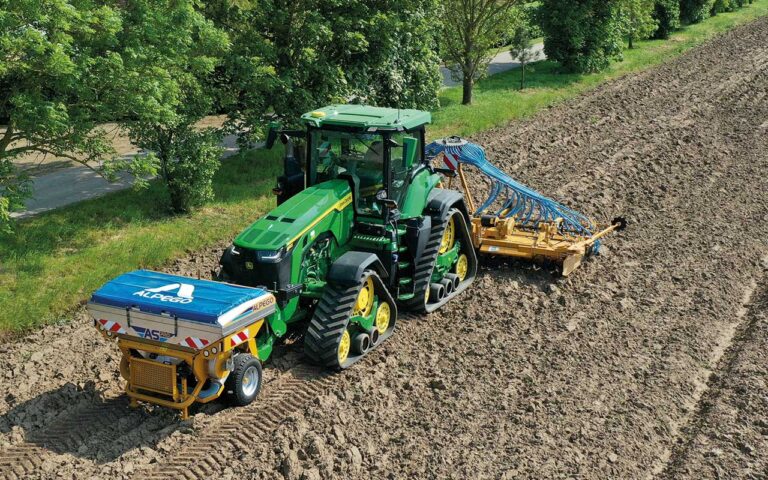With so many cultivation and establishment techniques used to counteract the effects of the weather, and the introduction of cover cropping and niche crops, the drill market continues to adapt.
Alpego
According to distributor Opico, the most popular Alpego drill on the UK market is the 6m folding combination, which combines the use of the Aspro front tank and a folding 6m Dtek Rapido power harrow and seeding bar.
The front tank has a standard hopper size of 1,400 litres, extendable up to 1,900 litres if additional capacity is required.
It’s offered with a hydraulic drive fan, 2+2 tramlines, electric half-width shut-off and front LED lights and markers, as well as a Dosal electronic metering unit, which is capable of 2-450kg/ha.
The metering unit includes a single segmented roller suitable for large and small seeds.
Moving to the rear of the tractor, the 6m Dtek Rapido is a heavy-duty folding power harrow suitable for tractors from 150-350hp, but when working with a front tank and seeding bar, more horsepower is recommended.
It features Alpego Twin Force TEK pairs of rotors fitted with calibrated Timken taper bearing sets, which ensure consistent build tolerances across the power harrow trough and, in turn, reliability and longevity.
The 6m version features four rotors a meter, offering close to 250mm rotor spacing. The model is also specified to include Rapido quick-fit drop forged tines, giving superior strength and durability.
The seeding bar, which is mounted to the rear of the 6m Dtek Rapido, is designed with 48 single disc coulters with an anti-bock flap as standard to prevent blockages in wet conditions.
Each coulter disc is made from 355mm boron steel and provides consistent penetration and longevity. This allows for a row spacing of 12.5cm (or 15cm with 40 coulters).
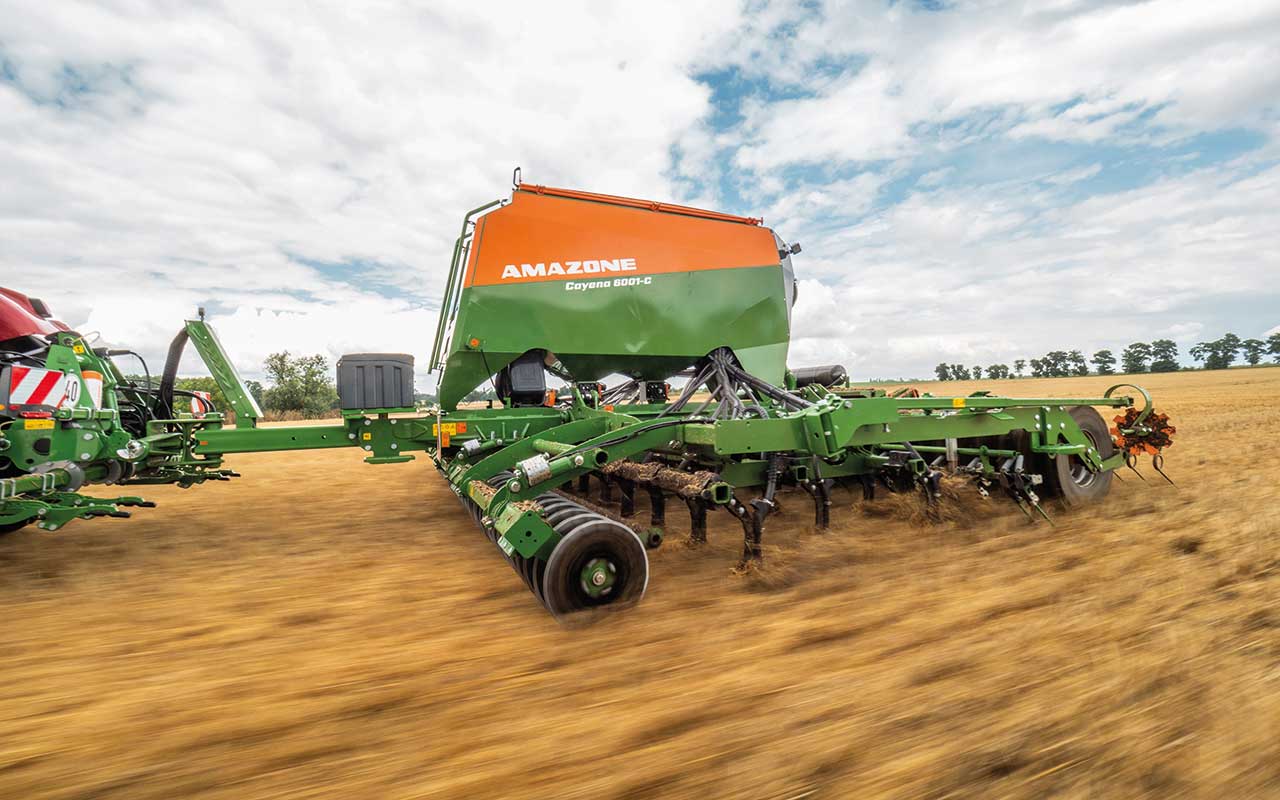
Amazone
Since the late 1970s, Amazone has used the TineTeC coulter across a wide variety of models.
The slim design of the chisel opener is said to provide excellent penetration for perfect depth control, even at shallow sowing depths, with minimal soil disturbance to reduce the risk of drying out the seedbed or generating a secondary germination of weed seeds and volunteers in the area around the seed row.
Long spaces between coulter banks mean the row spacing can be kept relatively narrow, down to 16.6cm, and yet enable surface organic matter to pass through the drill.
The downward action of the tine also removes the need for substantial weight in the drill, whereas a disc drill needs weight to counteract the upward forces generated by the rotation.
The TineTeC coulter is available on the Cayena 6001-C tine seeder, the Condor 12001-C and 15001-C direct tine seeder, as well as the Primera DMC 3000-C and 6000-2C multi-purpose tine drill.
With these models, operators can establish a cover crop straight into stubble or into a stale seedbed, sow a cash crop following last year’s or sow a cash crop into a cover crop.
Amazone tine drills are also equipped with the MultiBin system with a divided hopper along with additional seeder boxes.
Using the divided main tank, available with either two or three chambers, the drill can be used to sow multiple seed varieties as well as undersowing crops, companion crop planting, or mixing seed and fertiliser to target phosphate in the seeding zone.
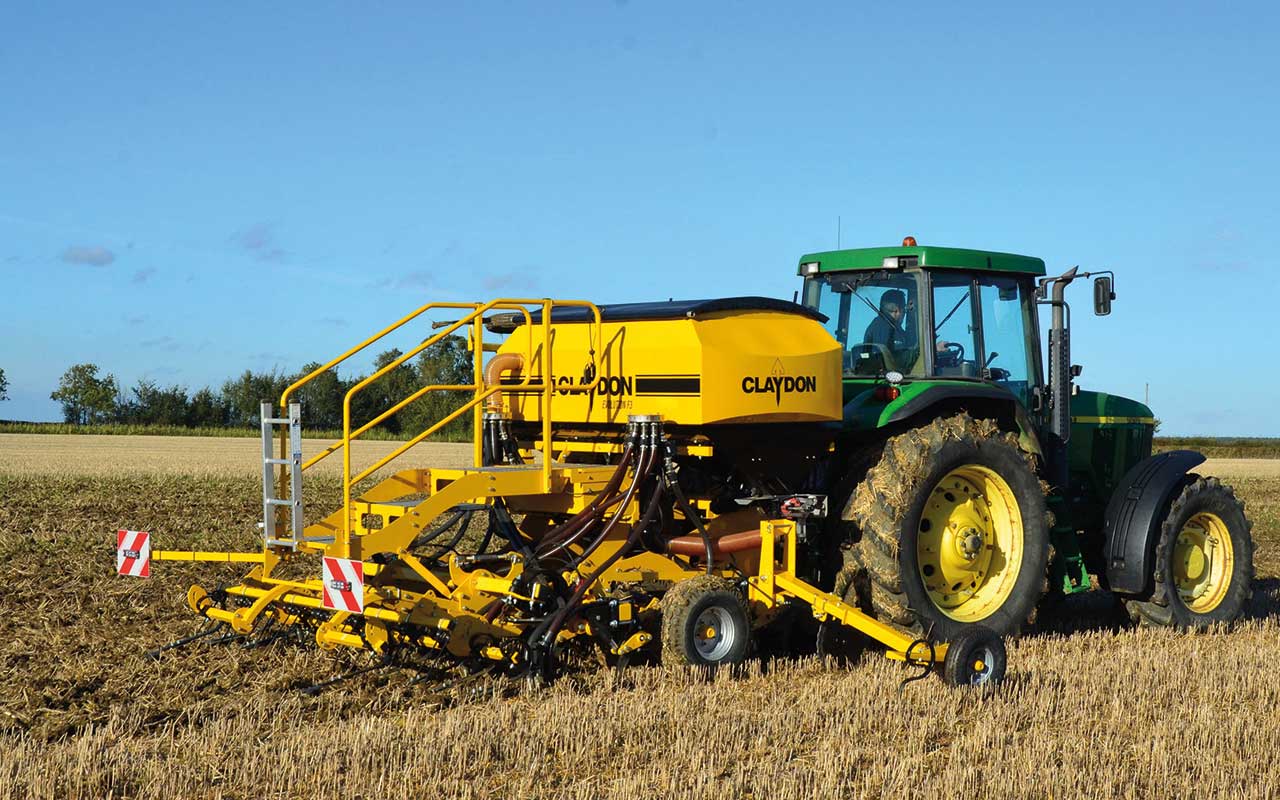
Claydon Drills
Central to Claydon’s Opti-Till system are the company’s Evolution M mounted drills, available in widths from 3m to 6m, and Hybrid T trailed drills with working widths from 3m to 8m.
Designed for direct seeding into stubbles, they are also effective in min-tilled or fully cultivated soils after consolidation and can apply fertiliser during drilling.
Its leading tine technology removes local compaction, fissures and aerates soil, with seeding depth adjustment from 0cm for low-disturbance operations down to 15cm for deep-rooting crops like OSR.
Claydon Evolution mounted drills feature hydraulic adjustment of seeding depth and improved access to the metering unit for easy calibration. They include 180mm A-shares, with a wide range of seeding share and boot options available.
Optional hydraulically adjustable front-mounted discs can be specified for seeding into high-residue situations, while twin tine and disc kit options can be specified for low-disturbance drilling.
Introduced in 2024, the Claydon Evolution Drill Toolbar and Evolution Front Hopper is available in rigid 3m or 4m versions, or as folding models with 4m, 4.5m, 4.8m, 5m or 6m working widths.
The Evolution Drill Toolbar includes one distribution head with 38mm seed delivery hoses.
A second distribution head with tramline valves can be optioned, allowing fertiliser or companion crops to be supplied to the leading tine or rear seeding tine, or split between the two.
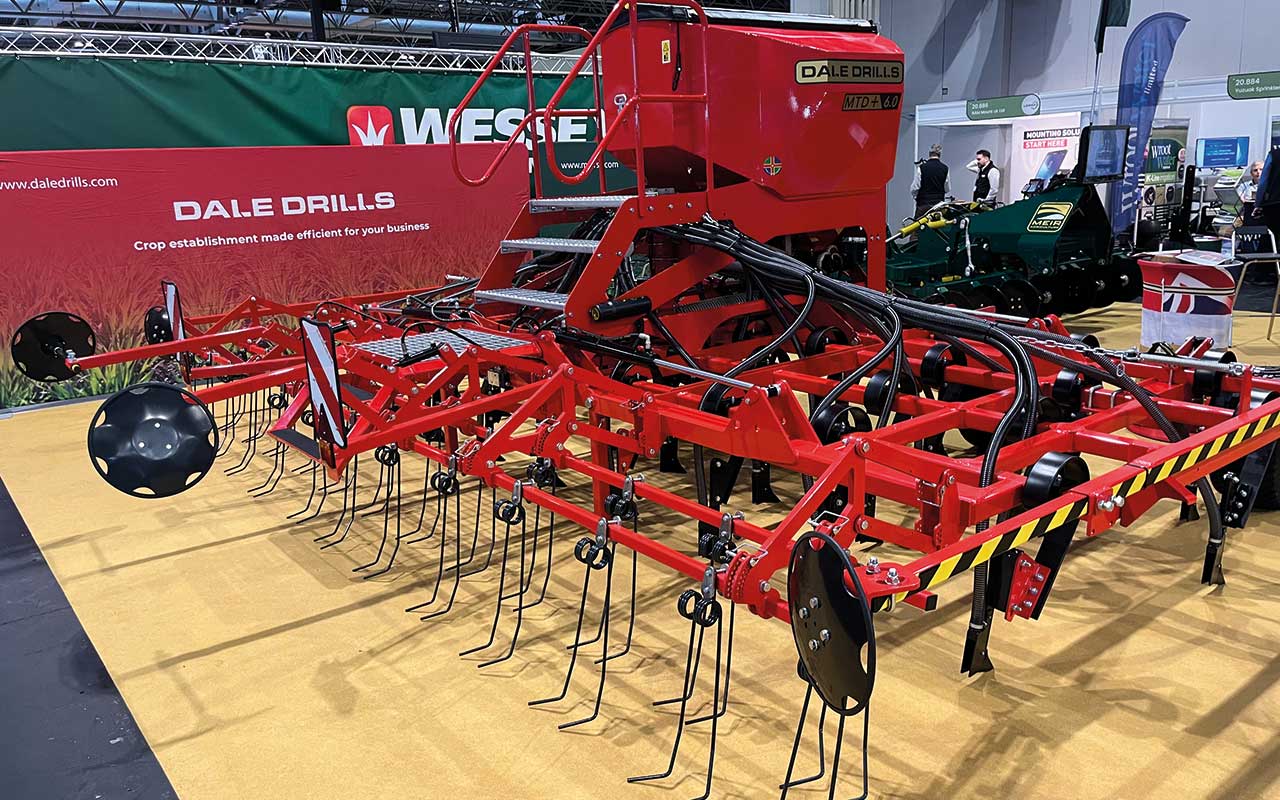
Dale Drills
In response to increasing demand, Dale Drills has expanded its Mounted Tine Drill (MTD) range to include the MTD+ Stretched Edition to offer improved stability, residue flow and operator convenience.
To offer a lower centre of gravity, the company has redesigned the 1t-capacity hopper, lowering it by 400mm and shifting the machine’s centre of gravity closer to the tractor.
This means a relatively small tractor can be used on the front of the drill, reducing the risk of compaction and keeping establishment costs lower.
Previously located centrally, the metering set-up, powered by the RDS Topcon control system, has been repositioned to the front of the machine.
This modification is said to improve accessibility, allowing operators to calibrate from a more comfortable position, making set-up quicker and more efficient.
To further accommodate high-residue conditions, the four rows of tines have had the front-to-back tine spacing extended from 400mm to 600mm.
This redesign reportedly increases trash clearance, reducing blockages and ensuring continuous, efficient drilling, even in fields with heavy crop residues.
Finally, steps have been taken to find the optimum weight distribution, with the new design eliminating the need for additional mounting structures. This results in a lighter, yet structurally sound design.
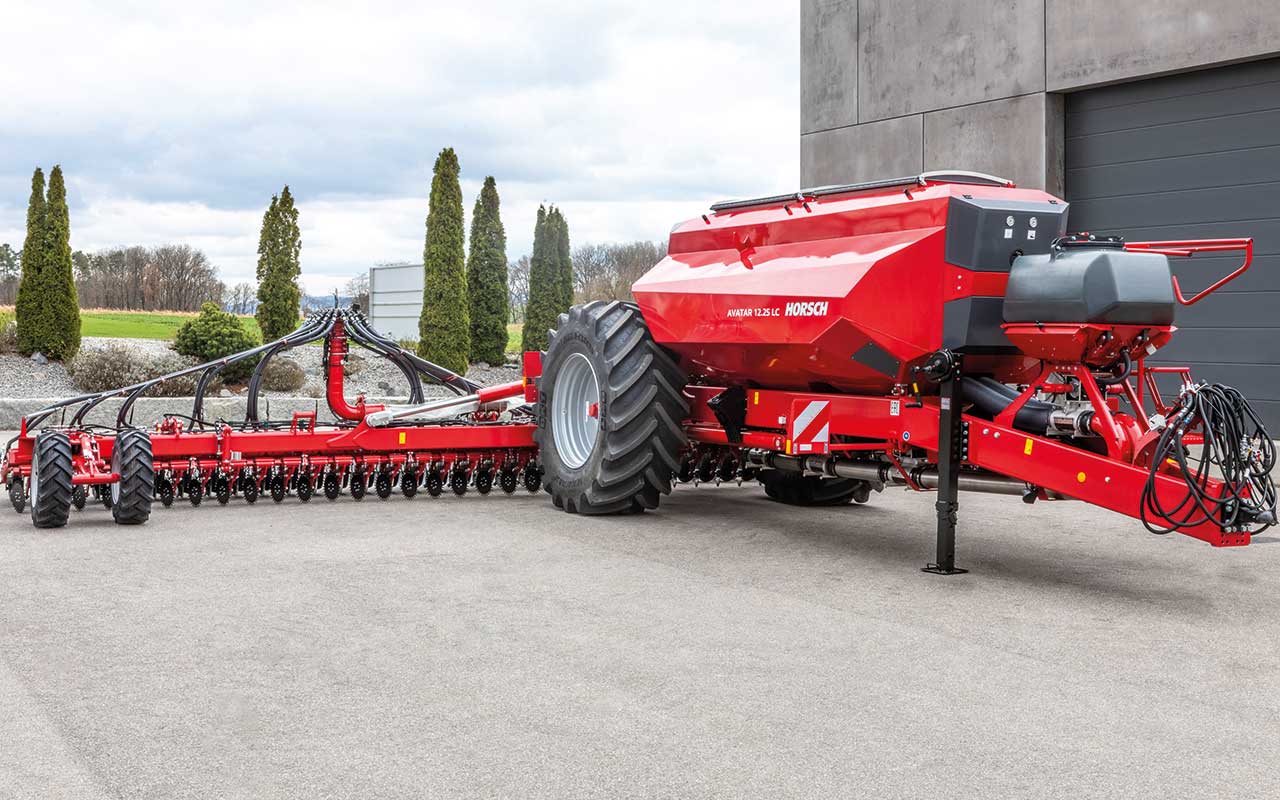
Horsch
Horsch has announced a new model in the Avatar drill family, offering increased capacity and the ability to sow up to four products.
The 12.25 LC has a triple tank as standard, with a capacity of 9,400 litres split 50:15:35, with the option to add a 400-litre Horsch MiniDrill. This is a 3,000-litre increase over the existing 12m Avatar SD.
According to the company, the seed wagon layout of the machine increases the drilling window, with the weight supported by large tyres and double support wheels, enabling the wings to adapt to the soil.
The SingleDisc coulters are arranged in 25cm spacings, which the company claims is ideal for different sowing regimes, as well as mechanical weed control. When folded, the Avatar 12.25 LC has a transport width of 3m.
The company also added a new series of Partner FT hoppers, extending the current range in both size and versatility.
A double-tank version of the 1,600-litre model has been added, alongside new double-tank units in 1,700-litre and 2,100-litre capacities. A 2,500-litre triple tank model has also been announced.
They can be combined with a wide range of Horsch machines, including seed drills to apply multiple products; toolbars to address weight balance issues; or with cultivators for deep fertilisation.
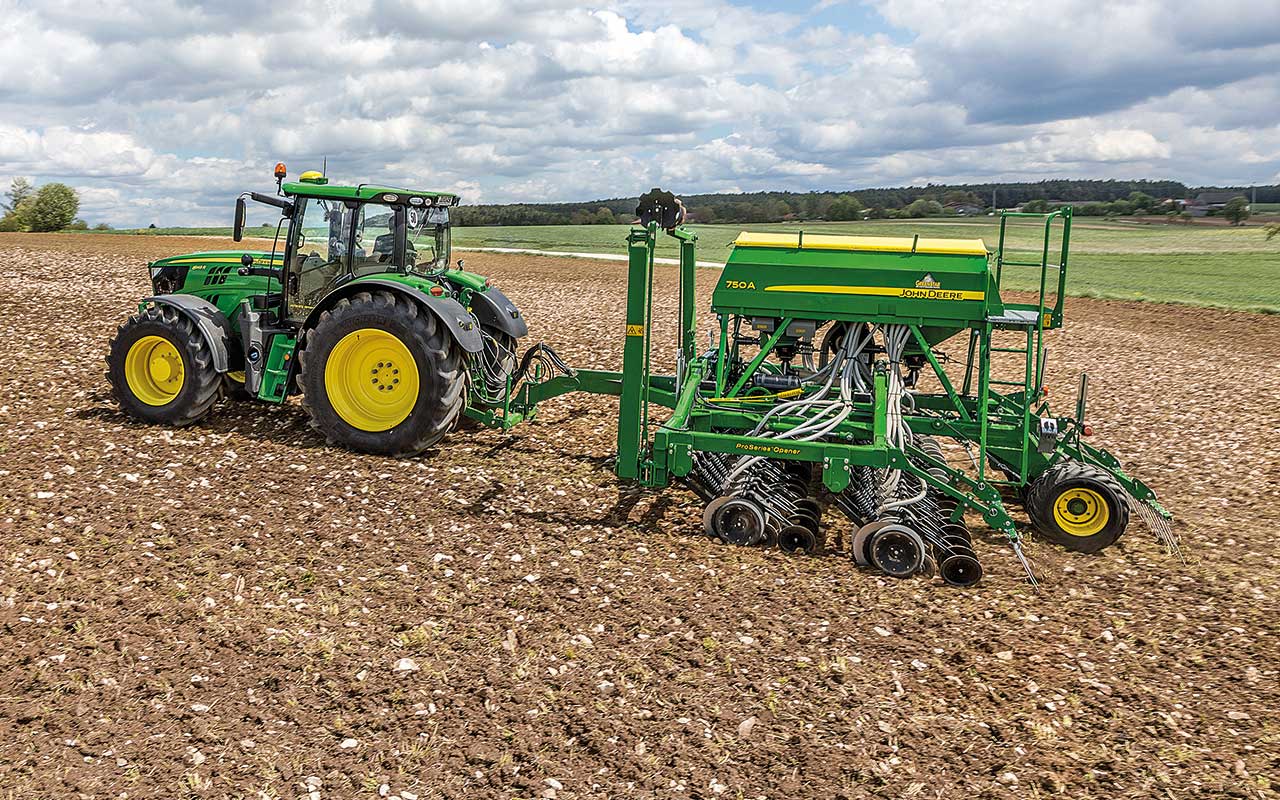
John Deere
John Deere offers the 750A drill, said to work in all cultivation regimes, from plough and power harrow through to no-till. It uses single-disc openers to ensure precise seed placement, even when direct drilling.
There are three width options – from 3m to 6m – with the largest machine boasting a 2,300-litre hopper capacity, in comparison to the 1,800-litre tank on the two smaller models.
As the width increases, so does the number of openers, which rises from 18 to 24, then 36 on the range-topper, with 16.6cm row spacing on all three.
The ProSeries openers are standard on every 750A, which the company says ensure optimum seed placement with perfect seed-to-soil contact and more uniform emergence.
Adjustable active hydraulic downforce with up to 250kg per opener ensures consistent seed depth and accuracy in no-till to low-till applications.
The 750A drill has a low power requirement, and only needs an 80hp tractor to pull the 3m machine, making it easier for farmers and contractors to establish crops with lower fuel requirements.
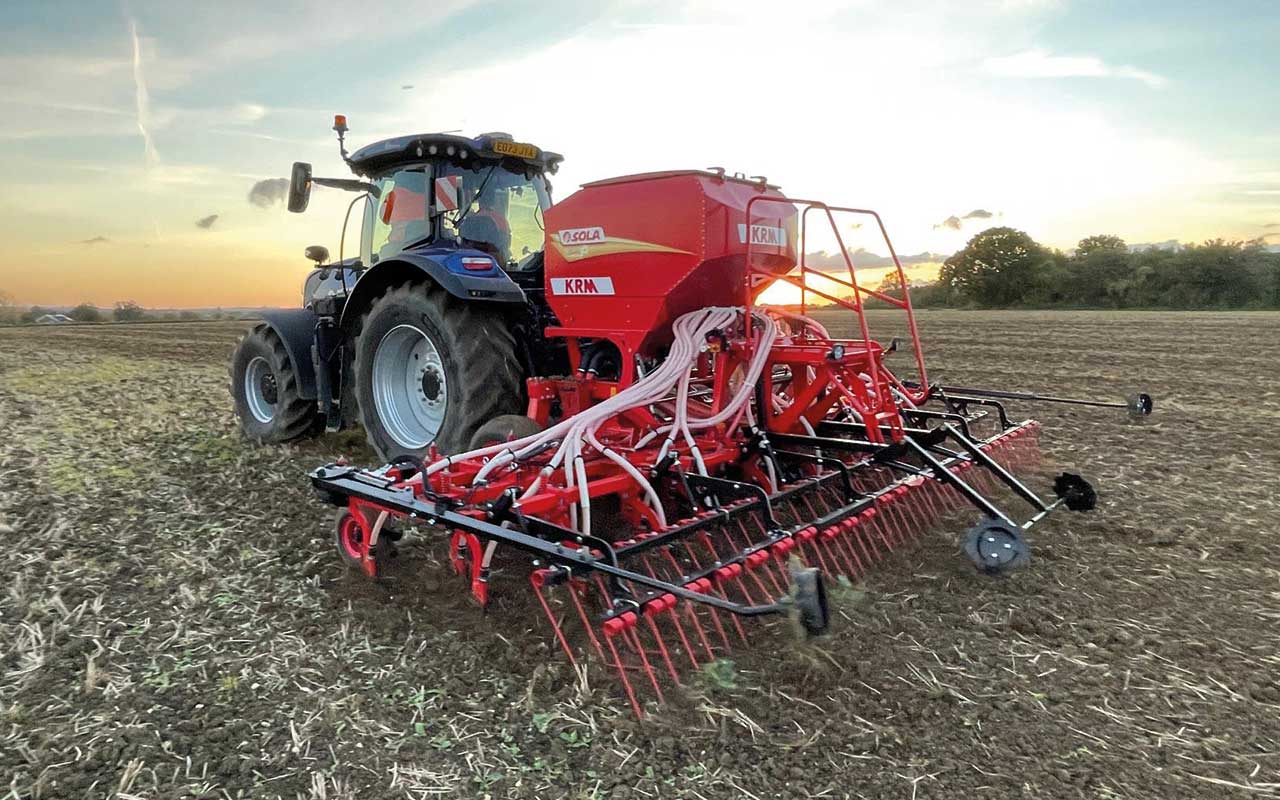
KRM
KRM offers a wide range of tine drills, of which the most popular model is the 6m SM-P, according to the company.
The coulters are mounted in four rows on a robust box-section frame, with 40cm between each row to provide maximum clearance for residue to flow through the drill.
At the top of the coulter leg is a double coil spring which can provide up to 180kg of downwards pressure to work into the toughest of seedbeds.
The tip of the coulter is 16mm wide and protected by tungsten carbide for a long working life.
The narrow tip is said to ensure better penetration and minimum disturbance. Row spacing can be set at 16cm, or for those interested in mechanical weeding 25cm is also an option.
The SM-P range uses a pressurised hopper. At the base of the hopper is a stainless-steel metering unit equipped with two electric motors to provide half-width shut-off.
The metering unit can handle rates from 4-400kg/ha and is fully Isobus controlled, allowing variable-rate application as well as GPS auto on/off and section control.
Customers can now add a small seed hopper, allowing additional products to be applied. The mini seed uses the same metering unit as the SM-P, making it suitable for all product types.
A distribution head is mounted below the drill’s access platform and feeds down to spreader plates mounted on the following harrow.

Kuhn Farm Machinery
Kuhn has updated its Espro range of trailed seed drills with new 3m 3002 and 4m 4002 fixed-width models, and the 4m 4002 R and 6m 6002 R folding versions.
The main upgrades focus on improved access and safety for filling the drill via a new mid-height platform on the side of the hopper, rather than just at the front. This prevents operators from overreaching to split bags.
Furthermore, a half-open mode – one side of the drill folded while the other remains in work position – allows the loader to get closer to the hopper with either bags or a bucket.
The hopper cover also has an automatic winding system and central locking.
A straight disc option, suited to users requiring minimum soil disturbance across each pass, can replace the large-diameter 460mm concave and serrated discs, which move soil across the drill’s full width.
The straight option ensures soil is only moved in the narrow band where the disc runs, helping to cut the power needed to pull the drill, and preserving soil moisture.
All of the new 1002-series drills retain established features from the outgoing Espro models.
These include 900mm rear wheels that are offset in two rows to reduce power demand and soil bulldozing in bad conditions; Crossflex seeding coulters for drilling at high speed; automated headland turns via Isobus; and optional Vistaflow valves for universal tramlining and individual blockage monitoring.
Universal metering allows rates from 1-430kg/ha for various seed sizes.
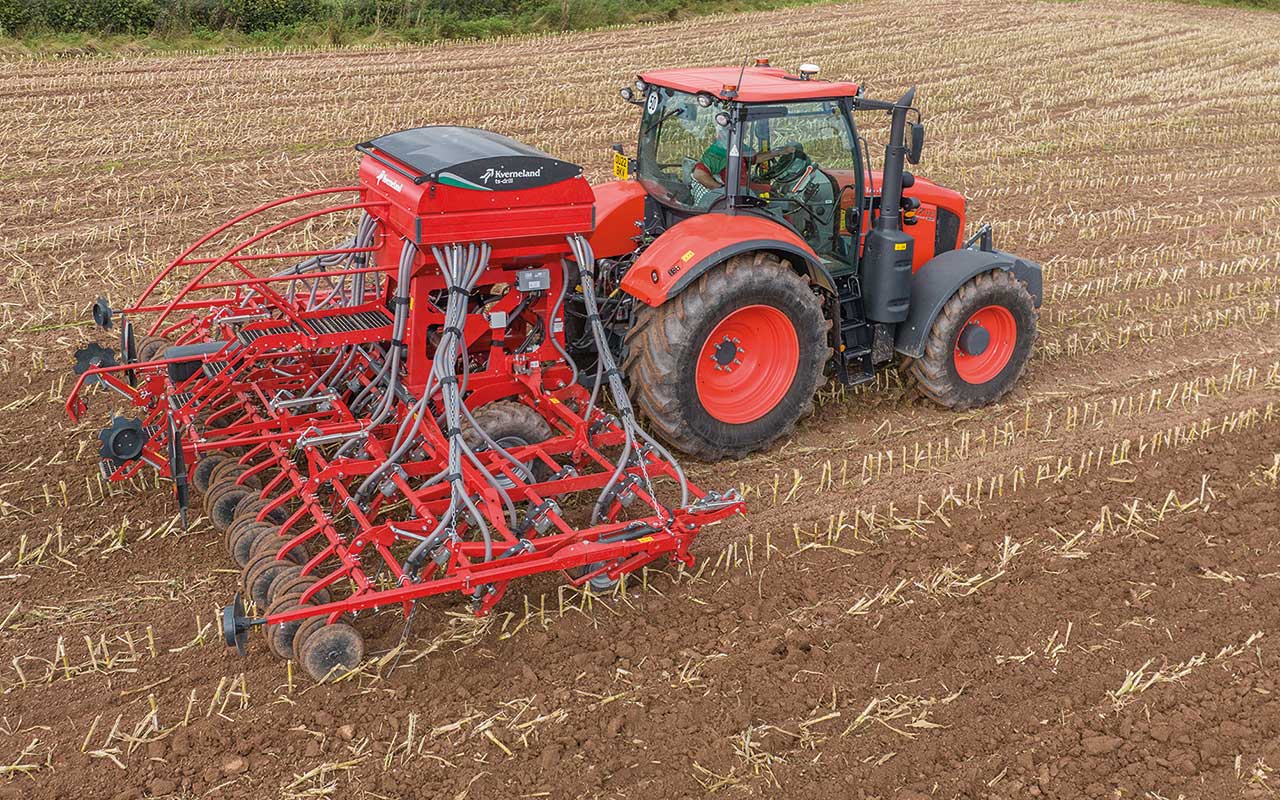
Kverneland
The Satio is a new model of pneumatic drill. Tractor-mounted, this lightweight, close-coupled solo unit has been developed for smaller tractors and is available in 3m and 4m rigid models, and 5m and 6m widths with hydraulic folding.
Hopper capacities can be 750 litres and 1,000 litres for rigid models, which use mechanically driven seed metering, while hydraulic folding models get a 1,750-litre hopper and Eldos electric seed metering.
CX-II coulters offer a preset 12.5cm or 25cm row spacing, but flexible fixing allows on-farm row-width adjustment for those seeking a different spacing.
Kverneland has also updated the TS-drill. According to the company, it can now work in low-disturbance operations. This is a result of a narrow tine being developed for use with the drill, allowing it to be put to work as a one-pass drill working direct into stubbles.
The narrow-tine version uses a 15mm point compared to the 45mm assembly used on the regular TS drill.
Combined with an all-new leg design, the low-disturbance tine gains 50kg more spring pressure, making it better suited to working in uncultivated ground.

Lemken
The new Solitair ST offers a working width of 12m, and can be used in any cultivation regime, according to Lemken. It can be fitted with a range of leading implements to provide the optimum conditions for the double disc coulters.
When a defined row pre-consolidation is required to improve seed contact with the soil, the plastic trapezoidal roller is available. If the seedbed is to be levelled and further crumbled, a levelling tine section can be fitted.
For targeted soil loosening, corrugated discs can be used as a leading tool in front of the OptiDisc seeding coulter. This produces fine soil in the seed furrow area for optimal seed placement.
The pressure-resistant double hopper is available in two versions: a 6,000-litre option divided equally into two hopper sections, or a 7,000-litre model divided into 3,000- and 4,000-litre sections.
According to the company, the combination of plastic hopper and modular metering system has the advantage that the whole system is fertiliser resistant.
Even the basic version of the Solitair ST comes with four metering units per hopper section, each supplying one distributor with seed.
The four distributor heads are positioned directly above the OptiDisc coulter bar, which features parallelogram-guided double disc coulters and trailing depth control rollers, which place seed or fertiliser at a row spacing of 12.5cm or, optionally, 16.7cm.
The coulter system is available in the hydraulic OptiDisc H version (up to 70kg coulter pressure) or the mechanical OptiDisc M version (up to 45kg coulter pressure). Both coulter pressure and seed depth can be adjusted independently of each other.
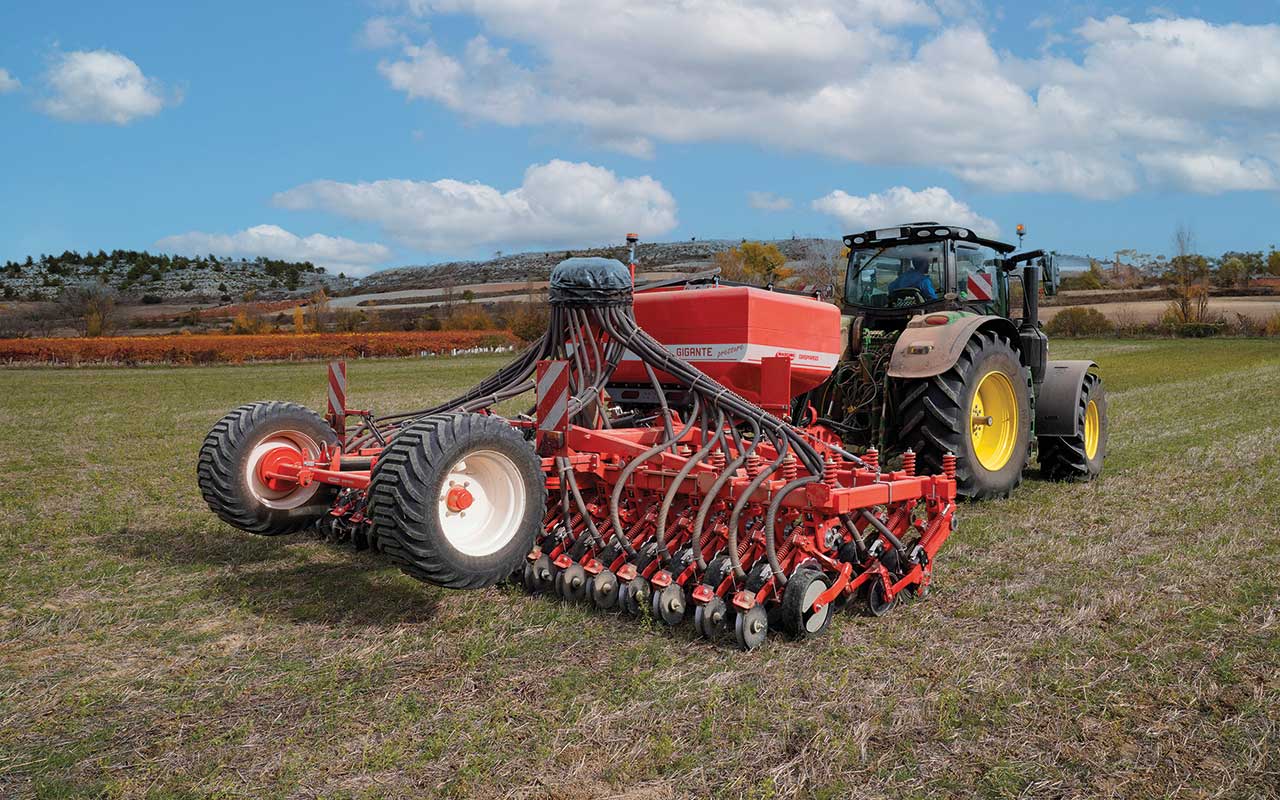
Maschio Gaspardo
Available in working widths of 3m, 4m, 5m and 6m, Maschio says the Gigante Pressure is designed to enhance sowing precision, even in challenging conditions, and has been engineered with the modern UK cereal grower in mind, offering a solution for sowing on dry, hard-baked stubbles.
It features a coulter design that includes independent, spring-loaded arms for the coulter elements and closing press wheels.
Additionally, the coulters are equipped with a two-degree, two-axis tilt, creating a channel in the soil with minimal soil disruption for good seed-to-soil contact and to promote uniform germination.
The choice of different disc types – plain or notched – gives growers the flexibility to adjust the drill to the prevailing soil conditions, whether they are working in light or heavy soils.
The machine is equipped with Isobus and GPS connectivity, and can adjust sowing rates and fertiliser application in real time.
A pressurised seed hopper with two compartments allows seed to be distributed on undulating ground with no loss of accuracy.
Later this year, Maschio will also introduce the Opera range of high-speed trailed cereal drills, available in 3m and 6m working widths.
Both models feature a pressurised split hopper with capacities from 3,000 to 5,100 litres, as well as maintenance-free double disc coulters leading to an overall reduction in downtime. The smaller Opera 300 uses a smaller tank with a venturi delivery system.

Pöttinger
Recent updates to the Pöttinger Aerosem FDD drill and Lion V power harrow combination include new coulter rail spacing options, brought in to match updates to the power harrow range.
The pneumatic implement-mounted seed drills and front hopper are now available with working widths of 5 and 6m.
This means that row spacings of 12.5cm or 15.5cm are possible with Aerosem FDD models with a working width of 5m when combined with the medium-weight Lion V 5040.
When using the Lion V 6040 powerharrow a coulter spacing of 15cm is offered, and the heavy-duty Lion V Master can be coupled with a 12.5cm coulter rail.
Combining the Aerosem FDD with the Lion V powerharrow series delivers high output for a versatile range of applications, according to the company.
Special attention has been paid to a compact design, and the result is an improved overview and optimised weight distribution.
In addition to a dual metering system and the IDS distribution head, the seed drill’s versatility is further increased by being able to attach and remove the coulter rail quickly.
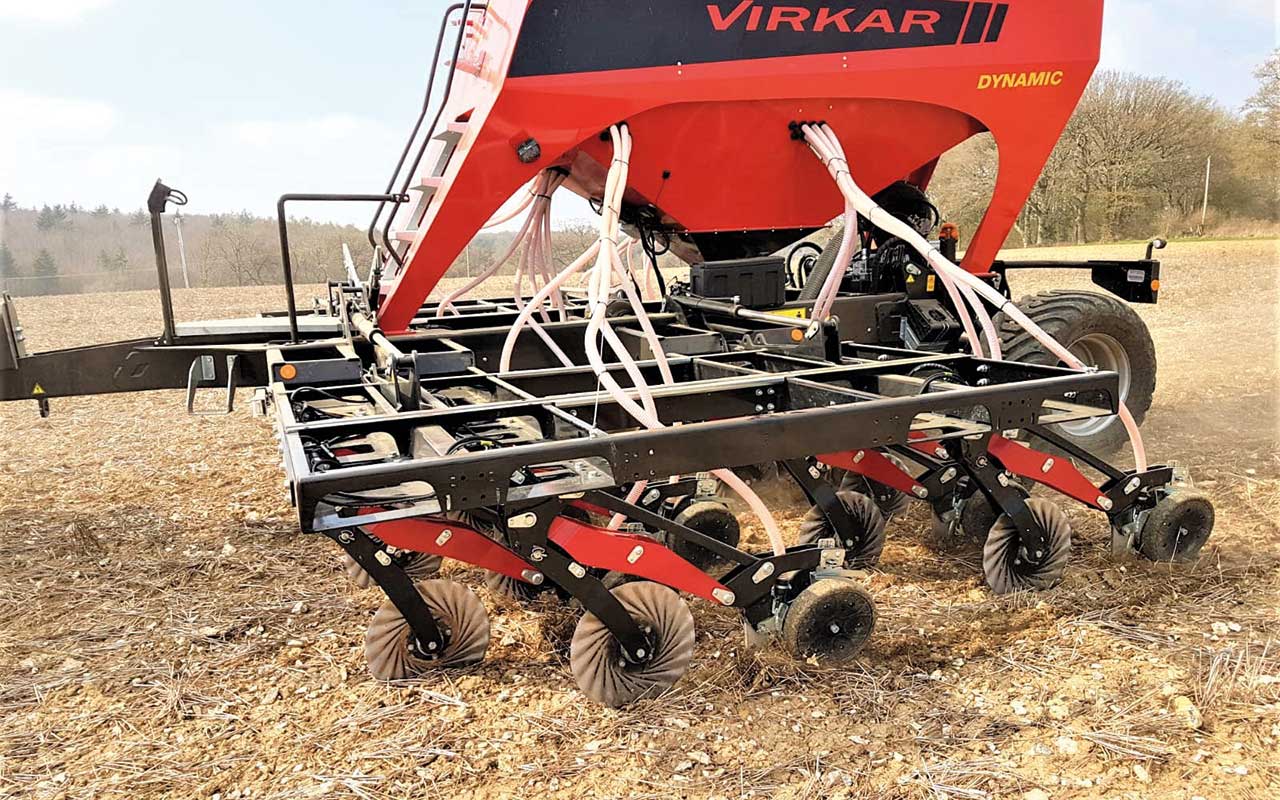
Samagri
Samagri imports and distributes both the Kockerling and the Virkar drill ranges. The company says the most popular Kockerling model is the 6m Jockey; a semi-mounted trailed drill using four rows of S-tines followed by a double STS roller and tine harrow.
Row spacing is 16.6cm with a 30mm band of seed. According to the company, the drill can be used on ploughing, min till, and direct, with an underframe clearance of 60cm to cope with copious amounts of trash.
With its large inter-tine clearance and lightweight, it has reportedly proved very useful in the late, wet autumn drilling slot. Tank size is 2,800 litres and the power requirement is 25hp/m.
The Virkar direct drills are available in four versions – the DC (disc and coulter), D (disc), C (coulter) and DD (double disc)
All use the same modular chassis, seed hopper and distribution equipment, all variants come in 4.5m, 5m,6m and 7m working widths, with the option of 19cm or 25cm row widths.
The hopper is 5,300 litres as standard or 7,000 litres as an option, both available as seed-only or seed and fertiliser, with a third hopper also available.
All drills are semi-mounted with a rear steering axle for increased manoeuvrability, and slope compensation.
The independent sowing elements on all versions come with 35cm of travel for true contour following, and up to 280kg of downward pressure.
Seed depth adjustment is via one spring-loaded lever for quick and easy adjustment. Coulter pressure is hydraulic and adjustable from the cab on the move.

Vaderstad
The new Seed Hawk 600-900C is a no-till seed drill available in working widths of 6m, 8m and 9m.
Vaderstad says the standout feature is the tine coulter system, which creates a clean seed slot, placing both seed and fertiliser in undisturbed soil for optimal germination and growth.
This is complemented by its 7,000-litre pressurised hopper, which is divided into three compartments.
This allows for independent mixing and application of up to three products, providing the versatility that is essential for today’s farming operations.
At its core is the Fenix III metering system, which handles the delivery of seed and fertiliser. Its design enables section control to optimise input use.
For example, the 6m version operates in two sections, while the larger 8m and 9m machines are divided into three sections.
The individually mounted dual-knife tine coulters are designed to work in all soil conditions. With a row spacing of 25cm, each tine coulter is paired with a packer wheel that ensures consistent seed depth and excellent soil-to-seed contact.
Hydraulic coulter downforce provides up to 190kg of adjustable pressure. Operators can fine-tune the downforce directly from the cab using the E-Control system, adapting the machine to varying soil types and conditions.
Additionally, fertiliser is placed 38mm offset from the seed row, promoting early root development.
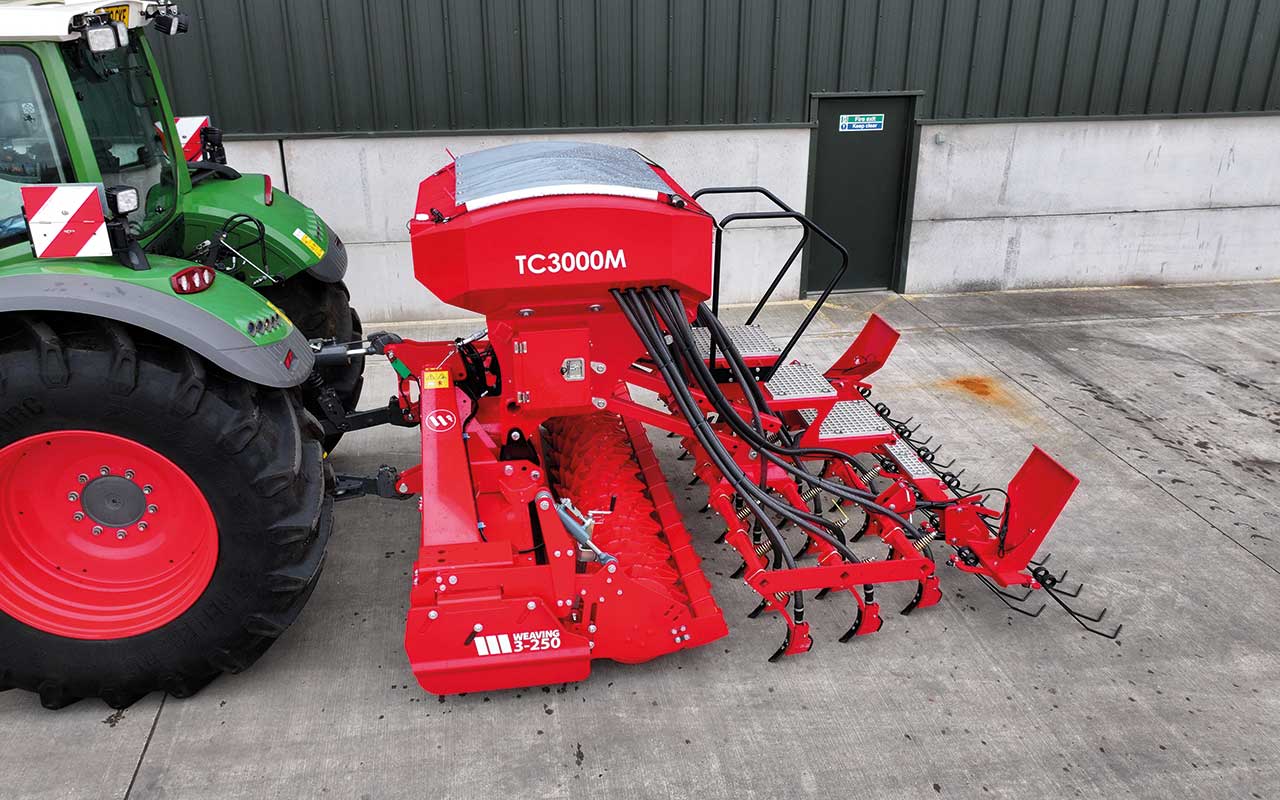
Weaving Machinery
Weaving Machinery has launched an improved tine combination drill, said to suit any conventional cropping system.
Available in 3m and 4m working widths, the newly designed drill comes with hydraulic depth control and an increased hopper capacity to allow a greater acreage to be drilled without leaving the cab.
It is also fitted with an electric metering unit and a hydraulic fan to maintain a constant drilling rate, and has three rows of auto- reset tines and a double following harrow.
Notably, the company has introduced a multi-fit system to enable Weaving or Kuhn power harrows to be used.
The company also continues to offer the established Sabre Drill for users looking to transition from conventional or minimum-tillage systems into direct-drilling set-ups.
Equipped with hydraulic depth control, side-to-side wing pivots allow for precise contouring and an extended settling area for handling large quantities of trash.
The depth wheels are situated in the middle of the drill, enabling front-to-back contour following and even weight distribution.
As well as side-to-side, the Sabre has front-to-back contour following due to the four centrally mounted depth wheels.
The drill comes with a 2,000-litre plastic hopper and tank sieve, wide flotation wheels, hydraulic depth control, wheel eradicators and a double row of following Z-harrows and LED road and work lights, all within a transport width of 3m.


